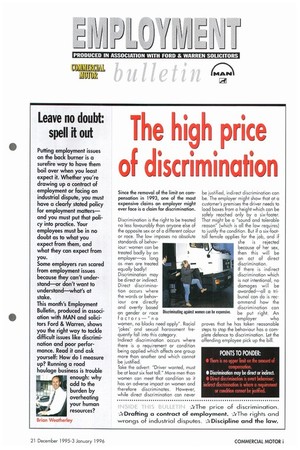The high prict of discrimination
Page 63

If you've noticed an error in this article please click here to report it so we can fix it.
Since the removal of the limit on compensation in W93, one of the most expensive claims an employer might ever face is a claim for discrimination.
Discrimination is the right to be treated no less favourably than anyone else of the opposite sex or of a different colour or race. The law imposes no absolute standards of behaviour: women can be treated badly by an employer—as long as men are treated equally badly!
Discrimination may be direct or indirect. Direct discrimination occurs where the words or behaviour are directly and overtly based on gender or race factors—"no women, no blacks need apply". Racial 'jokes' and sexual harassment frequently fall into this category. Indirect discrimination occurs where there is a requirement or condition being applied which affects one group more than another and which cannot be justified.
Take the advert: "Driver wanted, must be at least six feet tall." More men than women can meet that condition so it has an adverse impact on women and therefore discriminates. However, while direct discrimination can never be justified, indirect discrimination can be. The employer might show that at a customer's premises the driver needs to load boxes From a height which can be safely reached only by a six-footer. That might be a "sound and tolerable reason" !which is all the law requires) to justify the condition. But if a six-foottall female applies for the job, and if she is rejected because of her sex, then this will be an act of direct discrimination.
If there is indirect discrimination which is not intentional, no damages will be awarded—all a tribunal can do is recommend how the discrimination can be put right. An employer who proves that he has taken reasonable steps to stop the behaviour has a complete defence to discrimination. Let the offending employee pick up the bill.




























































































































